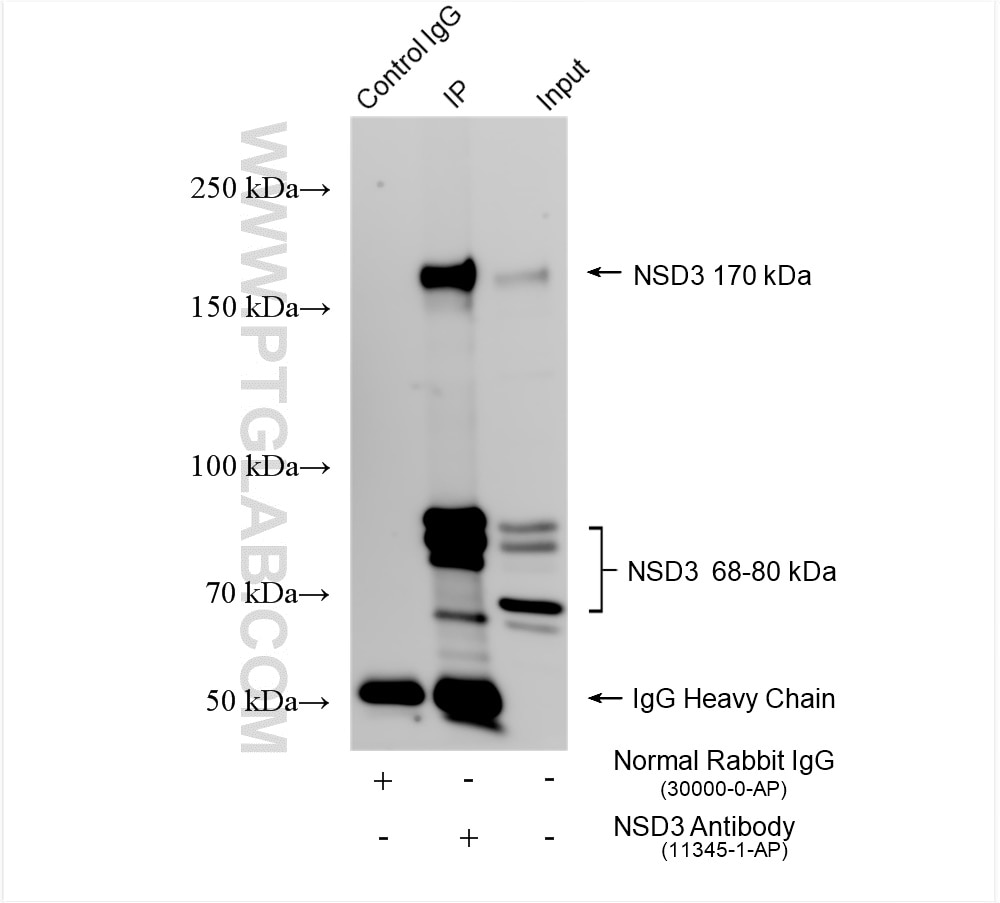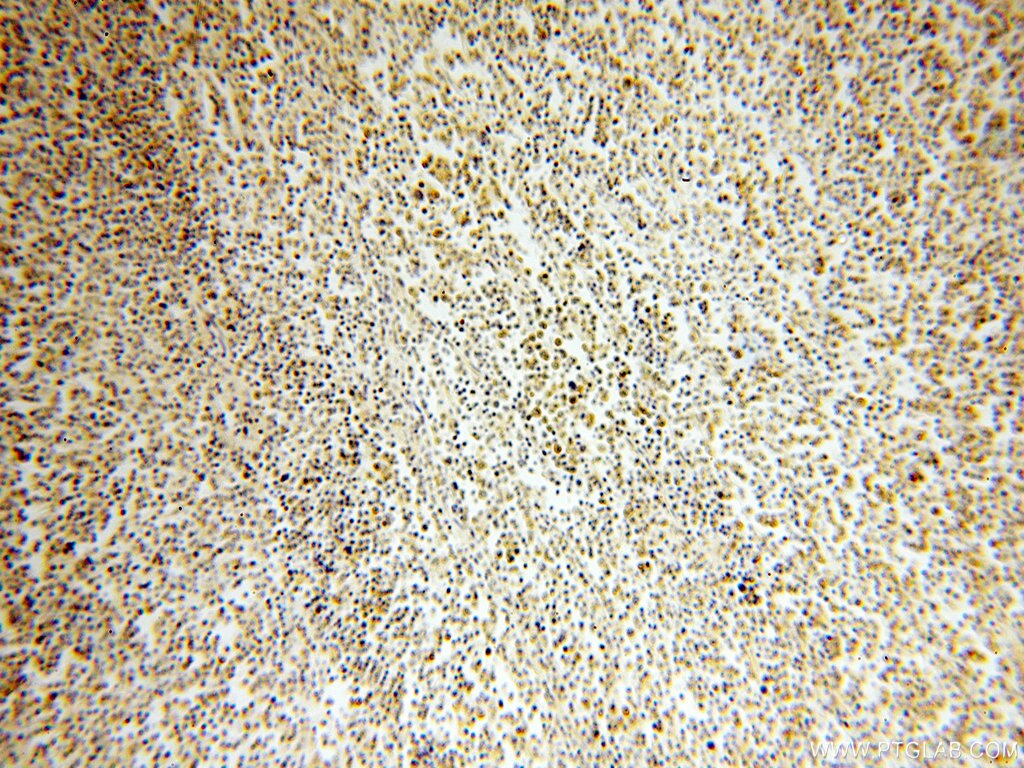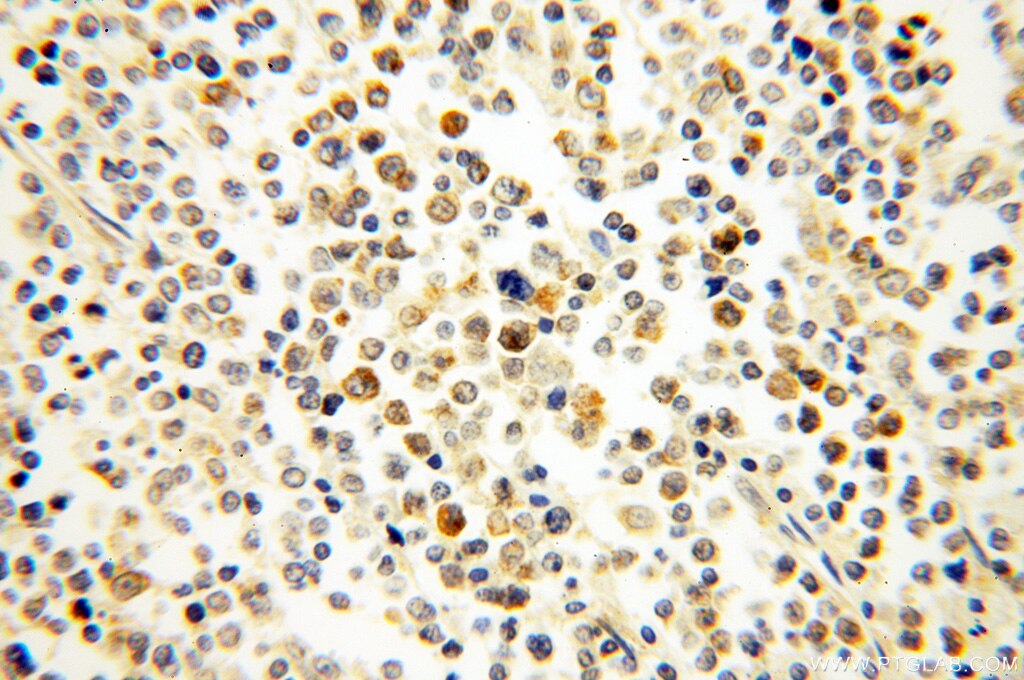- Phare
- Validé par KD/KO
Anticorps Polyclonal de lapin anti-NSD3
NSD3 Polyclonal Antibody for WB, IP, IF, IHC, ELISA
Hôte / Isotype
Lapin / IgG
Réactivité testée
Humain, rat, souris
Applications
WB, IHC, IF/ICC, IP, chIP, ELISA
Conjugaison
Non conjugué
N° de cat : 11345-1-AP
Synonymes
Galerie de données de validation
Applications testées
| Résultats positifs en WB | cellules HeLa, cellules HEK-293, tissu cardiaque de rat, tissu cardiaque de souris |
| Résultats positifs en IP | cellules HeLa, |
| Résultats positifs en IHC | tissu de lymphome humain il est suggéré de démasquer l'antigène avec un tampon de TE buffer pH 9.0; (*) À défaut, 'le démasquage de l'antigène peut être 'effectué avec un tampon citrate pH 6,0. |
| Résultats positifs en IF/ICC | cellules HeLa |
Dilution recommandée
| Application | Dilution |
|---|---|
| Western Blot (WB) | WB : 1:500-1:1000 |
| Immunoprécipitation (IP) | IP : 0.5-4.0 ug for 1.0-3.0 mg of total protein lysate |
| Immunohistochimie (IHC) | IHC : 1:20-1:200 |
| Immunofluorescence (IF)/ICC | IF/ICC : 1:50-1:500 |
| It is recommended that this reagent should be titrated in each testing system to obtain optimal results. | |
| Sample-dependent, check data in validation data gallery | |
Applications publiées
| KD/KO | See 3 publications below |
| WB | See 9 publications below |
| IHC | See 6 publications below |
| IF | See 2 publications below |
| ChIP | See 1 publications below |
Informations sur le produit
11345-1-AP cible NSD3 dans les applications de WB, IHC, IF/ICC, IP, chIP, ELISA et montre une réactivité avec des échantillons Humain, rat, souris
| Réactivité | Humain, rat, souris |
| Réactivité citée | Humain |
| Hôte / Isotype | Lapin / IgG |
| Clonalité | Polyclonal |
| Type | Anticorps |
| Immunogène | NSD3 Protéine recombinante Ag1894 |
| Nom complet | Wolf-Hirschhorn syndrome candidate 1-like 1 |
| Masse moléculaire calculée | 1437 aa, 162 kDa |
| Poids moléculaire observé | 160-170 kDa, 68-72 kDa |
| Numéro d’acquisition GenBank | BC012059 |
| Symbole du gène | WHSC1L1 |
| Identification du gène (NCBI) | 54904 |
| Conjugaison | Non conjugué |
| Forme | Liquide |
| Méthode de purification | Purification par affinité contre l'antigène |
| Tampon de stockage | PBS avec azoture de sodium à 0,02 % et glycérol à 50 % pH 7,3 |
| Conditions de stockage | Stocker à -20°C. Stable pendant un an après l'expédition. L'aliquotage n'est pas nécessaire pour le stockage à -20oC Les 20ul contiennent 0,1% de BSA. |
Informations générales
WHSC1L1, also named as NSD3 and DC28, belongs to the histone-lysine methyltransferase family and SET2 subfamily. It is histone methyltransferase. WHSC1L1 is a potently transforming oncogenes based on the number of altered phenotypes expressed by the cells. It contains a PWWP-domain that is a methyl-lysine recognition motif involved in histone code modification and epigenetic regulation of gene expression. Knockdown of WHSC1L1 in 8p11-12-amplified breast cancer cells resulted in profound loss of growth and survival of these cells. (PMID: 20940404). This antibody recognize the long isoform (160-170 kDa) and short isoform (68-72 kDa).
Protocole
| Product Specific Protocols | |
|---|---|
| WB protocol for NSD3 antibody 11345-1-AP | Download protocol |
| IHC protocol for NSD3 antibody 11345-1-AP | Download protocol |
| IF protocol for NSD3 antibody 11345-1-AP | Download protocol |
| IP protocol for NSD3 antibody 11345-1-AP | Download protocol |
| Standard Protocols | |
|---|---|
| Click here to view our Standard Protocols |
Publications
| Species | Application | Title |
|---|---|---|
Cancer Res NSD3-Induced Methylation of H3K36 Activates NOTCH Signaling to Drive Breast Tumor Initiation and Metastatic Progression. | ||
Cancer Res Transforming properties of 8p11-12 amplified genes in human breast cancer.
| ||
Mol Oncol Amplification of WHSC1L1 regulates expression and estrogen-independent activation of ERα in SUM-44 breast cancer cells and is associated with ERα over-expression in breast cancer. | ||
Sci Rep NSD2 contributes to oncogenic RAS-driven transcription in lung cancer cells through long-range epigenetic activation. | ||
Sci Rep WHSC1L1-mediated EGFR mono-methylation enhances the cytoplasmic and nuclear oncogenic activity of EGFR in head and neck cancer.
|













